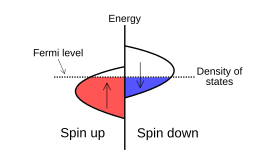Stoner criterion
The Stoner criterion is a condition to be fulfilled for the ferromagnetic order to arise in a simplified model of a solid. It is named after Edmund Clifton Stoner.
Stoner model of ferromagnetism

Ferromagnetism ultimately stems from Pauli exclusion. The simplified model of a solid which is nowadays usually called the Stoner model, can be formulated in terms of dispersion relations for spin up and spin down electrons,
where the second term accounts for the exchange energy, is the Stoner parameter, () is the dimensionless density[note 1] of spin up (down) electrons and is the dispersion relation of spinless electrons where the electron-electron interaction is disregarded. If is fixed, can be used to calculate the total energy of the system as a function of its polarization . If the lowest total energy is found for , the system prefers to remain paramagnetic but for larger values of , polarized ground states occur. It can be shown that for
the state will spontaneously pass into a polarized one. This is the Stoner criterion, expressed in terms of the density of states[note 1] at the Fermi energy .
A non-zero state may be favoured over even before the Stoner criterion is fulfilled.
Relationship to the Hubbard model
The Stoner model can be obtained from the Hubbard model by applying the mean-field approximation. The particle density operators are written as their mean value plus fluctuation and the product of spin-up and spin-down fluctuations is neglected. We obtain[note 1]
With the third term included, which was omitted in the definition above, we arrive at the better-known form of the Stoner criterion
Notes
- ^ a b c Having a lattice model in mind, is the number of lattice sites and is the number of spin-up electrons in the whole system. The density of states has the units of inverse energy. On a finite lattice, is replaced by discrete levels and then .
References
- Stephen Blundell, Magnetism in Condensed Matter (Oxford Master Series in Physics).
- Teodorescu, C. M.; Lungu, G. A. (November 2008). "Band ferromagnetism in systems of variable dimensionality". Journal of Optoelectronics and Advanced Materials. 10 (11): 3058–3068. Retrieved 24 May 2014.
- Stoner, Edmund Clifton (April 1938). "Collective electron ferromagnetism". Proc. R. Soc. Lond. A. 165 (922): 372–414. Bibcode:1938RSPSA.165..372S. doi:10.1098/rspa.1938.0066.














![{\displaystyle H=U\sum _{i}[n_{i,\uparrow }\langle n_{i,\downarrow }\rangle +n_{i,\downarrow }\langle n_{i,\uparrow }\rangle -\langle n_{i,\uparrow }\rangle \langle n_{i,\downarrow }\rangle ]-t\sum _{\langle i,j\rangle ,\sigma }(c_{i,\sigma }^{\dagger }c_{j,\sigma }+h.c).}](https://wikimedia.org/api/rest_v1/media/math/render/svg/0f294cd446ee4c9038386fde00157465b380b591)















